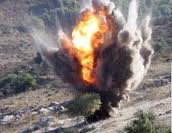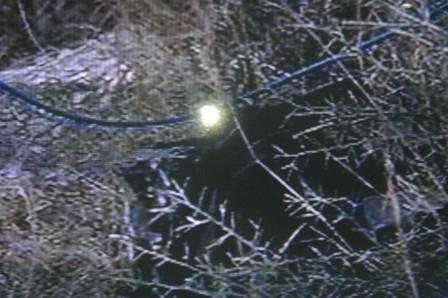Moqawama.org’s Exclusive on Cluster Bombs: Buried Alive

Sara Ibrahim
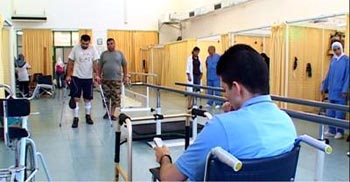
Like any child of age 10, Nabil Hassan a young boy from Arabsalim was excited to see Sojod Hills after the liberation on 23 May 2000.
"I wanted to see how "Israel" used to bomb us from there, I ran as fast as I could and that was the last time I ever ran", he said with his hand on his prosthetic leg.
Nabil told his story after 10 years of silence, "I never wanted to talk about it, I decided to leave it behind me long time ago, but maybe I can be a lesson learned by many children today", he said with a low pitch.
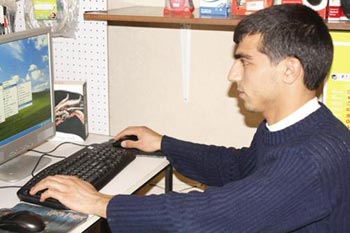
"I woke up at 8:30 a.m and wore my new pair of shoes and headed to Sojod Hills. At 6:00 p.m I woke up in the hospital wearing only one shoe, I couldn't see the other shoe nor my leg. It was the hardest feeling ever", he cried.
"I wasn't aware of what happened, my parents later on explained that I stepped on a cluster bomb. That one step was enough to put me down physiologically and psychologically for years", he said.
Nabil now is a 20 year old that was able to overcome his miseries, challenge the universe and prove that it wasn't the end of the world. He became a computer technician and opened his own computer shop.
Nabil continued that he was living a stabled life, although he's deprived from many things but he believes that he is lucky compared to other critical cases. "My maimed leg reminds me of the Palestinians and their sufferings and it also reminds me of the Arab ignorance", he said.
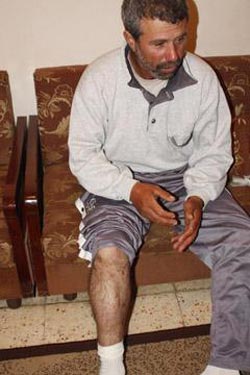
"I wish the Arabs care about the resistance and the importance of fighting "Israel" as much as they care about football, they'd rush to watch a Real Madrid v/s Barcelona match, but they sleep on the matters of life and death", he ended with a smirk.
Its not a Hollywood drama movie script, its a real tragedy in Habboush, a village in South Lebanon. A family of 9 members were the victims of a land full of mines on the 14th of August 2006.
Ibrahim Hattab, the brother of martyr Moussa Hattab and the Uncle of the 6 year old martyr Hadi Hattab, told us his painful story about his family.
"The nightmare began on the same day the 2006 war ended, we were stuck in the basement for 33 days, and we couldn't believe that we can finally drink tea in our own field. The whole family headed to the field each one of them holding his cup of tea", he said.
Ibrahim paused for a while as tears ran down his cheeks; he brought his brother's and nephew's picture. "After hearing the sound of the spoon swirling in the cup of tea, we heard a huge explosion followed by screams of pain. My nephew Hadi stepped on a cluster bomb, and it was enough to kill him and his father, maim my nephew Fatima's leg, as well as her brothers hand and injure my brother and his wife, and my cousins were injured badly as well", he cried.
While reciting the massacre, Ibrahim's baby daughter Aya was busy kissing her martyred uncle's picture, while his other 3 children were silently gazing outside the wall, recalling the tragedy.
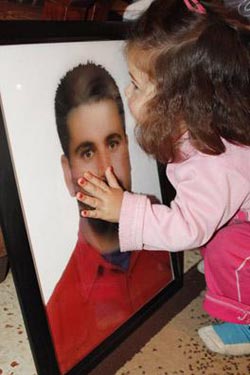
After a couple of minutes Hassan came in to visit his uncle. The 12 year old boy with a prosthetic hand had just come back from the barn after checking on his goats. "Those goats were about to die during the war, they were hungry and cold, but now I always make sure they are warm and in good health", he said with joy.
Hassan knew the past was brought up, but he was witty enough to change the subject. He poured a cup of milk and turned on the T.V trying to distract himself from remembering the bitter event.
A video of Hizbollah Secretary General Sayyed Hassan Nasrallah was on T.V, and suddenly the whole family was smiling with pride. "We devote our lives for the sake of that man, and for the sake of the resistance", Ibrahim said while pointing on the T.V.
Brigadier General Mohamed Fehmi, Director of the Lebanese Mine Action Center, explained to me that "Israel" used the cluster munitions in Lebanon during the 1982 invasion and in a massive quantity during 2006 war. "We were surprised by the huge quantity of cluster bombs used in southern Lebanon, especially during the last 72 hours of the war", he said.

Gen. Fehmi noted that since August 14 2006 until today, 361 civilians have become victims of cluster bombs. "Its such a tragedy to see a child's dream fade away in a second, no more football, or no more tennis, or no more photography", he said.
He added: "We received support from different countries such as: UAE, USA, Germany, UK, Czeck republic, Australia, Norway, Italy, and Denmark yet there is a huge shortfall of funds in our humanitarian operation".

In 2007 LMAC was assisted by 111 teams from different NGOs such as the Norwegian People Aid, the Dan Church Aid, the Federation Suisse de Deminage, the Handicap Int. and the Swedish Rescue Service Agency. While now only 18 teams are working due to the lack of enough funds. "We still have 49.5% of contaminated areas that need to be cleared as soon as possible, the victims are increasing and we don't have much time", he said.

Gen. Fehmi explained that their mission is to maintain a sustainable Mine Action capability able to mitigate all impacted areas in 5 years through Clearance, Mine-Risk Education, Mine Victim Assistance, and Advocacy according to national and international standards.
"We lost a lot of our men but we believe that it is better to die on your feet than live on your knees. We will continue our mission till the end even if our lives were the cost", he ended.

Like any child of age 10, Nabil Hassan a young boy from Arabsalim was excited to see Sojod Hills after the liberation on 23 May 2000.
"I wanted to see how "Israel" used to bomb us from there, I ran as fast as I could and that was the last time I ever ran", he said with his hand on his prosthetic leg.
Nabil told his story after 10 years of silence, "I never wanted to talk about it, I decided to leave it behind me long time ago, but maybe I can be a lesson learned by many children today", he said with a low pitch.

"I woke up at 8:30 a.m and wore my new pair of shoes and headed to Sojod Hills. At 6:00 p.m I woke up in the hospital wearing only one shoe, I couldn't see the other shoe nor my leg. It was the hardest feeling ever", he cried.
"I wasn't aware of what happened, my parents later on explained that I stepped on a cluster bomb. That one step was enough to put me down physiologically and psychologically for years", he said.
Nabil now is a 20 year old that was able to overcome his miseries, challenge the universe and prove that it wasn't the end of the world. He became a computer technician and opened his own computer shop.
Nabil continued that he was living a stabled life, although he's deprived from many things but he believes that he is lucky compared to other critical cases. "My maimed leg reminds me of the Palestinians and their sufferings and it also reminds me of the Arab ignorance", he said.

"I wish the Arabs care about the resistance and the importance of fighting "Israel" as much as they care about football, they'd rush to watch a Real Madrid v/s Barcelona match, but they sleep on the matters of life and death", he ended with a smirk.
Its not a Hollywood drama movie script, its a real tragedy in Habboush, a village in South Lebanon. A family of 9 members were the victims of a land full of mines on the 14th of August 2006.
Ibrahim Hattab, the brother of martyr Moussa Hattab and the Uncle of the 6 year old martyr Hadi Hattab, told us his painful story about his family.
"The nightmare began on the same day the 2006 war ended, we were stuck in the basement for 33 days, and we couldn't believe that we can finally drink tea in our own field. The whole family headed to the field each one of them holding his cup of tea", he said.
Ibrahim paused for a while as tears ran down his cheeks; he brought his brother's and nephew's picture. "After hearing the sound of the spoon swirling in the cup of tea, we heard a huge explosion followed by screams of pain. My nephew Hadi stepped on a cluster bomb, and it was enough to kill him and his father, maim my nephew Fatima's leg, as well as her brothers hand and injure my brother and his wife, and my cousins were injured badly as well", he cried.
While reciting the massacre, Ibrahim's baby daughter Aya was busy kissing her martyred uncle's picture, while his other 3 children were silently gazing outside the wall, recalling the tragedy.

After a couple of minutes Hassan came in to visit his uncle. The 12 year old boy with a prosthetic hand had just come back from the barn after checking on his goats. "Those goats were about to die during the war, they were hungry and cold, but now I always make sure they are warm and in good health", he said with joy.
Hassan knew the past was brought up, but he was witty enough to change the subject. He poured a cup of milk and turned on the T.V trying to distract himself from remembering the bitter event.
A video of Hizbollah Secretary General Sayyed Hassan Nasrallah was on T.V, and suddenly the whole family was smiling with pride. "We devote our lives for the sake of that man, and for the sake of the resistance", Ibrahim said while pointing on the T.V.
Brigadier General Mohamed Fehmi, Director of the Lebanese Mine Action Center, explained to me that "Israel" used the cluster munitions in Lebanon during the 1982 invasion and in a massive quantity during 2006 war. "We were surprised by the huge quantity of cluster bombs used in southern Lebanon, especially during the last 72 hours of the war", he said.

Gen. Fehmi noted that since August 14 2006 until today, 361 civilians have become victims of cluster bombs. "Its such a tragedy to see a child's dream fade away in a second, no more football, or no more tennis, or no more photography", he said.
He added: "We received support from different countries such as: UAE, USA, Germany, UK, Czeck republic, Australia, Norway, Italy, and Denmark yet there is a huge shortfall of funds in our humanitarian operation".

In 2007 LMAC was assisted by 111 teams from different NGOs such as the Norwegian People Aid, the Dan Church Aid, the Federation Suisse de Deminage, the Handicap Int. and the Swedish Rescue Service Agency. While now only 18 teams are working due to the lack of enough funds. "We still have 49.5% of contaminated areas that need to be cleared as soon as possible, the victims are increasing and we don't have much time", he said.

Gen. Fehmi explained that their mission is to maintain a sustainable Mine Action capability able to mitigate all impacted areas in 5 years through Clearance, Mine-Risk Education, Mine Victim Assistance, and Advocacy according to national and international standards.
"We lost a lot of our men but we believe that it is better to die on your feet than live on your knees. We will continue our mission till the end even if our lives were the cost", he ended.


